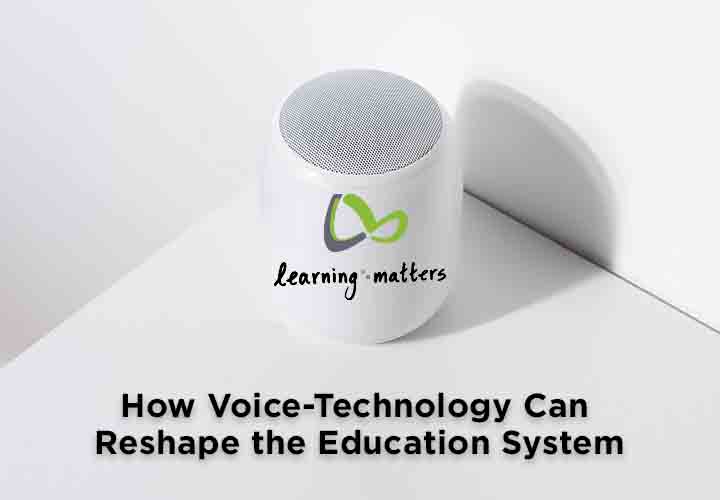"Hey Alexa, place an order for Kellogs cornflakes on Amazon Pantry, please."
Click on the play button to hear Alexa's response:
That’s it! Your requested product is on your doorstep within a couple of days after giving the voice command to Amazon Echo, a smart speaker, and a home assistant.
Alexa, Siri or the ever-reliable Google Maps guiding you to your destination are some of the applications of voice technology popularly known to us. But the potential of voice technology is much more than this. COVID-19 has already fuelled the next wave of innovation in the education sector. While we are just about adapting to virtual learning, voice technology combined with the power of artificial intelligence is already springing up to be a key force in teaching and learning.
Educators and ed-tech companies alike are incessantly working on innovations to making teaching and learning more effective in current times.
Students in Sri Kanchi Sankara Vidyalaya, Thiruvidaimarudur, Kumbakonam learning English from Tara
While e-learning in the form of video-based or visual learning has been instrumental in aiding the learning process during the pandemic, its accessibility is questionable. While students in private schools can attend online classes fairly easily and with all the necessary equipment, those in rural schools are facing multiple challenges with unreliable internet connectivity, minimal to poor access to necessary platforms for e-learning, and the high-cost factor of devices.
As video-based learning requires a strong internet connection, it becomes a hurdle for teachers and students in semi-urban and rural India to completely rely on it. Most of the private schools rich with resources are effectively making use of Google Classrooms, Zoom, Microsoft Teams, Blackboard, Tata Class Edge, etc., However, teachers and students of the semi-urban and rural regions don’t have access to technology and high-quality solutions and training like their urban counterparts.
Is there a feasible solution to this challenge? Yes. The answer is voice technology.
Why Voice Technology?
Students in Sri Kanchi Sankara Vidyalaya, Ganapathy Agraharam, Kumbakonam learning from Tara
When compared to visual learning, voice-assisted technology is not only economical and easily accessible but also comes with its own set of unique benefits. Here are a few of them:
-
Voice-assisted technology is very light on hardware as users only need a small device that supports voice, such as an EchoDot, that is easily portable.
-
Voice-enabled devices have very simple interfaces. So there is no intimidation or fear for people who aren’t as tech-savvy as others.
-
The bandwidth required for voice-enabled technology to function seamlessly is much less than that required for video-based learning. 512 Mbps is the minimum bandwidth needed so even a 3G connection is sufficient.
-
Many voice devices come with battery back-up and so, a consistent electricity supply is not required.
-
Because of factors #1, 2, 3, and 4 above, this technology is much more easily deployed than other technology solutions.
-
Voice-assisted learning solutions make use of the most natural way in which human beings learn - through listening and speaking. We all learn languages like this. So, using conversation-style learning, which is what voice technology is based on, ensures learning that is natural and effective.
-
Voice technology isn’t just a passive interface. When it is pedagogically-sound and thoughtfully-designed, the interface will not only tell learners they are incorrect but also explain why and correct them.
-
Voice technology can repeat lessons, exercises, and assessments as many times as learners need, without any fatigue.
-
Voice technology provides a non-judgmental environment for learners to confidently make mistakes and learn. With a voice teacher, there is no fear of embarrassment or making mistakes.
-
Voice technology supports individualized learning as well as pair, small-group, and large-group learning. One device can serve a class of 30-50 students because of the excellent mic array that can pick up voices from larger ranges. Imagine a class of 30 students clustered around one smartphone on a video call. There’s no comparison.
-
With big players bringing in voice technology in multiple Indian languages, learning is not restricted only to English.
-
It is easily extendable to any academic subject and any use case.
-
There is no concern about children being exposed to longer screen time. The ‘only audio' medium gives no chance to get distracted with visuals and therefore, kids become more attentive.
Voice technology will become the Frontrunner in Education
With minimal features but maximum capability and impact, there is no doubt that voice technology powered by AI has greater ROI and is going to be the next big education trend. Not only can it enhance learning among students but also amongst teachers. It makes high-quality educational solutions accessible and affordable to semi-urban and rural schools. Most importantly, it makes solutions scalable and sustainable.
Most of us have a ubiquitous image of e-learning which is visual-based. However, to ensure that no child (or teacher) is deprived of learning and that they realize their full potential, we must look towards and support voice technology in education.


Comments